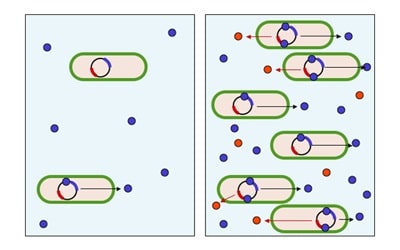Western blotting is a common lab technique used to detect and analyze proteins. It also happens to be a really long and complicated procedure, with many steps along the way that are easy to mess up. How do you make sure that your Western blot is successful? Avoid the following five ways to destroy your Western blot:
[Edit: Now this is “4 ways to destroy your western blot!” – we had to retire the first one because it was inaccurate. Sorry about that!]
1. Lose track of the front/back, top/bottom; blot the wrong side of the membrane
It’s easy to lose track of where your proteins are on the gel once you’ve begun the transfer. My advice is to develop a rule of thumb that you always follow when removing gels from the gel box. For instance, I always slice a tiny amount of gel off the upper right hand corner of the gel. That way, even if the gel itself gets turned around, you can re-orient yourself.
Within the gel itself, the proteins are evenly distributed. On a membrane, however, the proteins will only be present on one side. Therefore, you also have to keep track of what side of the membrane the proteins are on. To keep the same orientation on the membrane as on your gel, you need to stack them carefully when setting up the transfer – lay the back of the gel on the front of the membrane. If you’re having trouble figuring it out, try to picture exactly how and where the proteins are moving when you apply charge. And don’t forget to mark which side of the membrane is the front when the transfer is complete!
2. Forget to include a ladder
A molecular weight marker needs to be included on every gel! And make sure you use a pre-stained ladder, or you’ll be helpless (ask me how I know this).
3. Get your antibodies wrong
Antibody problems are probably the most common cause for a failed Western blot – using the wrong concentration, using the wrong secondary, or using the wrong reporter. Antibody concentrations need to be optimized for both primary and secondary antibodies; check the literature, the manufacturer’s recommendations, and your lab mates’ experiences for what dilution you should be using. If the antibody is too dilute, you will need a very long exposure to see anything. If it is too concentrated, the signal will be so strong that it will be difficult to distinguish individual bands. Next, double check that your secondary antibody recognizes the species of your primary antibody, i.e. if your primary is rabbit, the secondary should be anti-rabbit. Finally, make sure your secondary is conjugated to a reporter, such as HRP (hydrogen peroxide), otherwise you’ll just have a stack of antibodies with no way to detect them.
4. Over- or under- expose the blot
When it comes to imaging your blot, determining the exposure length can be somewhat of an art. Under-exposure of your blot will result in very faint bands, and over-exposure can result in an entirely black film. If you always use the same antibody at the same concentration, you probably have a good idea how long the blot needs to be imaged for. It’s a good idea to take a range of exposures, ranging from a few seconds to several minutes.
Have you found any different (perhaps even more creative) ways to destroy your western blot? Use the comments to tell us how.






